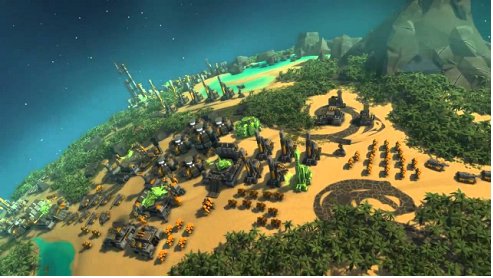The original article series was written for a long-defunct Total Annihilation fansite in 2004. Ten years on, the article series is being mildly updated for the current era, when computer games are more popular than ever, and there is a variety of highly interesting RTS games not thought of in 2004 are on the market – among others, AI Fleet Command, R.U.S.E., Creeper World, Sword of The Stars and Eufloria – although I note most of these are primarily 2D. It still retains at it’s core, however, the concepts which it was originally built on.
The primary focus of this series was and remains on a field which unfortunately still lags, isometric-view 3d RTS games. One recent example is “Grey Goo”, which while it has some interesting unit and side concepts is still tied to much the same paradigm as the RTS games of 1997, when Total Annihilation was new and the C&C series current game was Red Alert and it’s expansions – and it has little to offer in terms of advancing the genre.
There have been several attempts at an “update” to the formula, two of which have purported to be the spiritual sequels in one way or another to Total Annihilation – Supreme Commander and Planetary Annihilation. Both of these games are, however, notably flawed as successors to TA in one aspect or another and in this article series I would like to lay out a different way to advance on the conventions initiated in Total Annihilation.
In fact, unfortunately, in many cases the sequels to games have abandoned what made the first game in the series great and compromised on design principles. Supreme Commander 2 was nearly 10% lower in its metacritic score and 2/10 lower in its fan reviews on metacritic, and many of the complaints were sadly predictable – a “dumbing down” of the original, small maps and generally less strategy required in favour of tactics.
To begin the article series, one basic question must be asked – what is a RTS game. Many “RTS” games today are in fact RTT games – Real Time Tactics. While a fun sub-genre in its own right, commanding small squads of relatively individual complex troops and leaders is not really “strategic” – and, many of the games require you have a very high APM rate. (Actions Per Minute – essentially how fast you must click the mouse on the right options to compete!)
The key example for this is, of course, the wildly successful Starcraft 2. Blizzard have once again created a massive-selling hit and created an intricate and detailed story as well as a robust multiplayer game. What it is not…is a game of strategy. (It also remains essentially 2.5d, with defined height layers and hovering “flying” units)
This series is not intended in any way to denigrate other genres, or to insult game developers. It’s about broadening horizons and exploring possibilities. Too, Total Annihilation was an amazing game not only because it was a large-scale strategy game but because it was a data-driven game with a very flexible pseudo-3d engine, which the community spent years building tools and content for.
Neither is it meant to dictate single solutions, but to explore gameplay contentions and possibilities. It is, admittedly, PC-centric but the vast majority of the strategy game community is and remains on the PC so this is not a major drawback. It is far from comprehensive, and future articles may consider elements which it does not.
As well as this introduction and a concluding post, there are seven major articles in this series;
Part 3 – Artificial Intelligence



